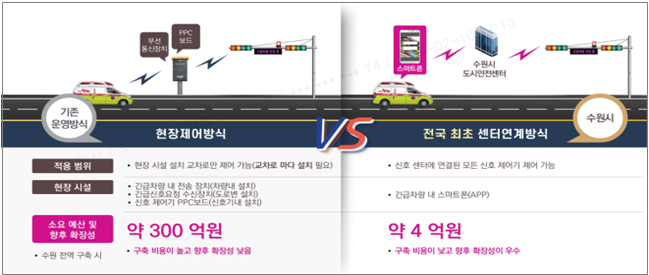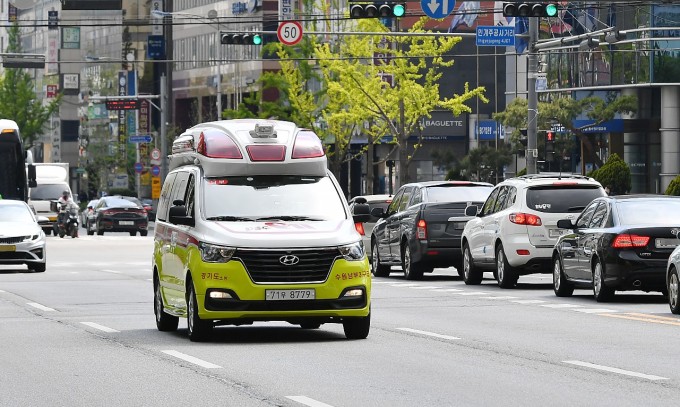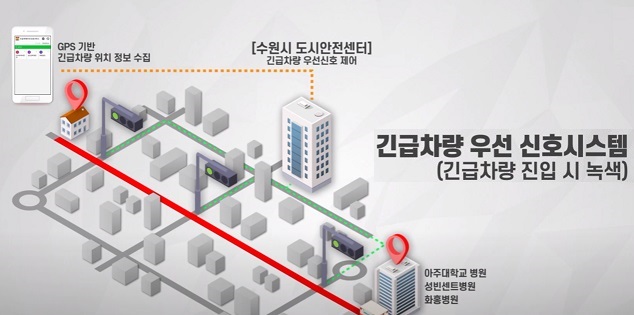The “Firsts” and “Bests” of Government Innovation
The Korean Government will accredit the “Firsts” of our innovations that contributed to the public’s comfort and safety, and select the “Best” cases of government innovation to spread as examples to our many institutions.
The First
First in Korea Priority Signaling for Emergency Vehicles.
- Suwon City Office
- 2023-12-29

In 2020, the City of
Suwon, Gyeonggi Province, introduced the nation’s first ‘Priority Signaling System for Emergency Vehicles’. Splitting Traffic with Signaling, holding onto Life
in the Golden Hour! |
Content
‘An ambulance, running through an
intersection with priority signaling ⓒ Suwon City |
■ A Safety Innovation for Emergency Patients and Paramedics
The priority
signaling system for emergency vehicles is designed to automatically change
lights to green when emergency vehicles including ambulances with emergency
patients are entering intersections, made possible by the Integrated Safety
Center tracking vehicle locations through GPS.
The City of Suwon, Gyeonggi Province established on January
20th , 2020, for the first time in Korea, and has since operated,
a ‘center-based’ priority signaling
system for emergency vehicles in all areas of the city.
Utilizing this
system, as soon as an emergency situation is registered to the emergency safety
center, the regional municipality’s central control center can identify and
provide an ideal route to emergency vehicles. Furthermore, by predicting when
emergency vehicles are expected to pass an intersection in their path and
providing green light signaling, it can assist in the rapid passage of
emergency vehicles.
‘Priority Signaling
for Emergency Vehicles’, responsible for guaranteeing the golden hour of
emergencies, is currently operated by using either the ‘on-site control method’
or ‘center-connected method’
※
The ‘on-site control method’ was
first implemented by the City of Uiwang,
Gyeonggi Province, in 2017.
For cost reduction
and operational efficiency, the City of Suwon actively pushed for a
‘center-connected method (Central control method)’, that had the Suwon
Integrated Safety Center control the signaling system of all intersections
within the path of emergency vehicles. After a total of 400 million Won in
budgets and 7 months of development, the
city of Suwon, on January 20th , 2020, introduced Korea’s first
priority signaling system for emergency vehicles that utilized a central ‘center-connected method’.

Deputy team leader Lee, Byung-ho of the City Office of
Suwon, who led the development of this system,
introduced how the idea came to life, stating that he “thought problems for
emergency vehicle systems could have a similar solution to how bus arrival
times at bus stops could be calculated for passengers based on the location of
buses”.
The ‘priority
signaling system for emergency vehicles’ that began implementation for
emergency ambulances at fire stations beginning January 2020, were later
applied to police vehicles, leading to 1,827 accumulative cases of operation
leading up to December 2022. Thanks to the introduction of the priority
signaling system, the mean passage time for emergency vehicles maneuvering 1km
was reduced by 56.3% from 3 minutes 20 seconds to 1 minute and 27 seconds.
The priority
signaling system for emergency vehicles is an example of how recognition of an
existing issue, such as emergency vehicle dispatch and patient transport delays
from complicated and change-prone road conditions, could be transformed into a
specific improvement of systems. It is an accomplishment coming from the close
cooperation of the City government of Suwon, fire departments, the police, and
various research institutions of traffic safety.
Building on this
accomplishment, the system has increased speed for the transportation process
of patients with time-sensitive conditions, such as severe trauma and acute
myocardial infarctions, to medical facilities, greatly enhancing not just the
protection of the public’s lives, but also the value of public safety.
The priority
signaling system for emergency vehicles, first implemented in January, 2020 for
emergency dispatch vehicles at fire stations, were later expanded and applied
to fire trucks and police vehicles in August, 2021, leading to 1,827 total
cases of operation leading up to December 2022.
In addition, the
system was spread to 8 municipalities in the Gyeonggi Province, and 10 other
areas around the nation, with several regions competing to introduce the system
to their roads.
The Ministry of Land, Infrastructure and Transport (MOLIT)
and the National Fire Agency are in the
process of test driving a system utilizing a combined form of the ‘on-site
control method’ and the ‘central-control method’, and hopes to further develop
the system into a nationwide ‘Wide-area Priority Signaling System for Emergency
Vehicles’.



